Updated on Feb 22, 2022
We are drawing this information from the websites of a variety of trustworthy organizations (e.g. World Health Organization, the United States Centers for Disease Control and Prevention, the Massachusetts State Department of Public Health, the Ministry of Health and Family Welfare, Government of India, the Boston Public Health Commission and the Cleveland Clinic among others). Some of this language is used word for word, and other language is paraphrased. We would like to acknowledge the hard work of these organizations in compiling this information.
Important terms:
WHO: World Health Organization
CDC: United States Centers for Disease Control and Prevention
COVID-19: COVID-19 is a new disease, caused by a novel (or new) coronavirus (SARS-CoV-2) that has not previously been seen in humans. There are many types of human coronaviruses including some that commonly cause mild upper-respiratory tract (sinuses, nasal passages, pharynx and larynx) illnesses. In COVID-19, ‘CO’ stands for ‘corona,’ ‘VI’ for ‘virus,’ ‘D’ for ‘disease’ and ‘19’ for ‘2019.’
For Vaccine FAQs- click here.
How COVID-19 Spreads
How does COVID-19 spread?
People can catch COVID-19 from others who have the virus. 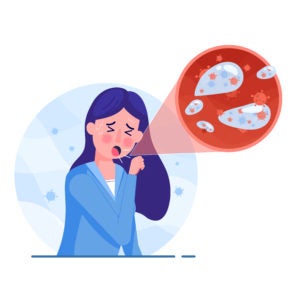 The disease can spread from person to person through small droplets coming from the nose or mouth when a person with COVID-19 coughs or breathes out. These droplets can be breathed in by other people or land on their eyes, nose, or mouth. Sometimes, these droplets may contaminate surfaces they touch. People can get infected by touching eyes, nose, or mouth with hands that have the virus on them. People who are closer than 6 feet from the infected person are most likely to get infected.
The disease can spread from person to person through small droplets coming from the nose or mouth when a person with COVID-19 coughs or breathes out. These droplets can be breathed in by other people or land on their eyes, nose, or mouth. Sometimes, these droplets may contaminate surfaces they touch. People can get infected by touching eyes, nose, or mouth with hands that have the virus on them. People who are closer than 6 feet from the infected person are most likely to get infected.
Source: https://www.cdc.gov/coronavirus/2019-ncov/prevent-getting-sick/how-covid-spreads.html
Can COVID-19 be caught from a person who has no symptoms?
People are most likely to spread the disease when they have the symptoms, that is, “symptomatic” or sick. This is because the main way the disease spreads is through droplets expelled by someone who is coughing or sneezing. However, it is possible that some spread can happen before people show symptoms. Social distancing is recommended even for people without symptoms.
Can someone who has been quarantined for COVID-19 spread the illness to others?
Quarantine means separating a person or group of people who have been exposed to a contagious disease but have not developed illness (symptoms) from others who have not been exposed. The purpose of quarantine is to prevent the spread of that disease.
A person exposed to the COVID-19 virus usually develops an illness within 14 days of exposure. Because of this, a person who might have been exposed to the virus from another infected person should quarantine themselves for a period of 5-14 days (depending on their vaccination status). During the quarantine period, they can develop and/or spread the illness to others. Beyond the quarantine period, the person is considered to be not at risk of developing or spreading the illness.
Can COVID-19 spread through drinking water?
The virus that causes COVID-19 has not been found in drinking water. Conventional water treatment methods that filter and disinfect the water should remove or inactivate the virus that causes COVID-19.
Adapted from source: https://www.cdc.gov/coronavirus/2019-ncov/prevent-getting-sick/how-covid-spreads.html
Can COVID-19 spread through food?
Coronaviruses spread from person-to-person through respiratory droplets. There is no evidence to suggest the spread of COVID-19 through food. Before preparing or eating food it is important to always wash your hands with soap and water for 20 seconds for general food safety.
Can COVID-19 spread through packages that come through the mail/ post?
It is unlikely that a person with COVID-19 will infect the contents of a package. Since packages are moved and exposed to different conditions and temperatures, it is also unlikely that people will catch COVID-19 from the outside of a package. However, it is advised to wash your hands with soap and water for at least 20 seconds, after touching objects handled by other people.
Will warm weather stop the outbreak of COVID-19?
Seasonal trends have not been seen with COVID-19 meaning COVID-19 transmission does not increase or decrease during certain seasons. Some other viruses, like those that cause the common cold and flu, spread more during cold weather months but that does not mean it is impossible to become sick with these viruses during other months.
Symptoms, Testing and Treatment
What are the symptoms of COVID-19?
The main symptoms of COVID-19 are fever, cough, and shortness of breath or difficulty breathing. Other symptoms include repeated shaking with chills, muscle pains, headache, sore throat and new loss of taste or smell.
Those who are ill may also have fatigue (tiredness), nasal congestion (stuffy nose), nausea or diarrhea; however, many people who become infected do not have any symptoms. Most people who get COVID-19 get better without needing special treatment. However, some become very ill.
If you have trouble breathing, continuous pain the chest, new confusion, inability to stay awake or pale/ blue colored lips or nail beds, seek emergency medical care immediately. Please talk to your doctor about any other symptoms that are severe or concerning to you.
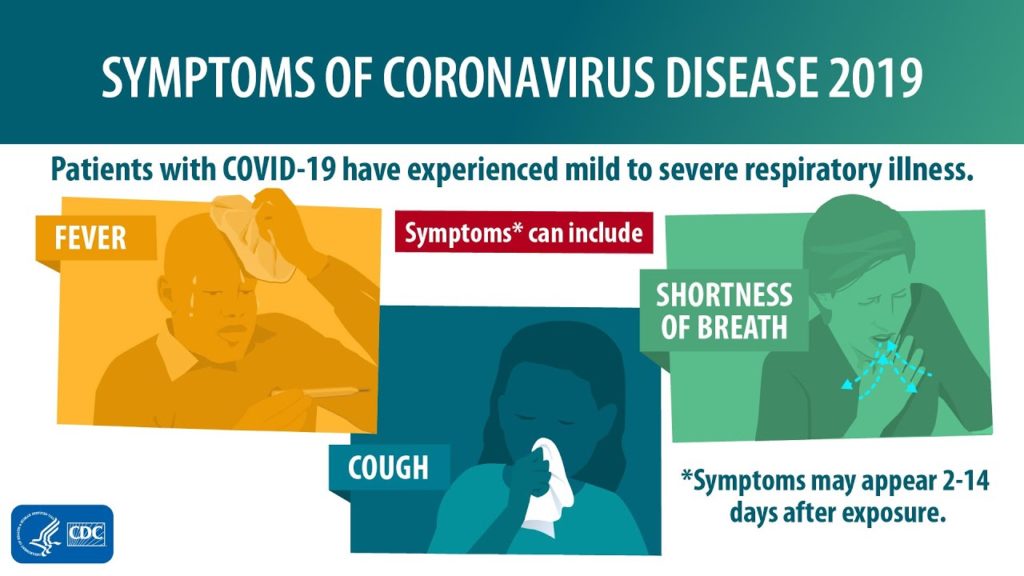
Are the symptoms of COVID-19 different in children than adults?
No. The symptoms of COVID-19 are similar in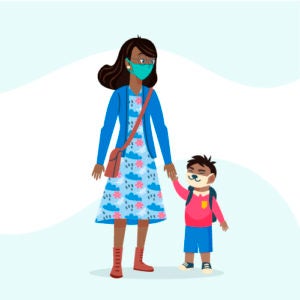 children and adults. However, children with confirmed COVID-19 have generally shown mild symptoms. Reported symptoms in children include cold-like symptoms, such as fever, runny nose, and cough. Children can also have a sore throat, difficulty breathing, poor feeding, vomiting and diarrhea. Similar to adults, many children who become infected do not have any symptoms. Current evidence suggests that children with medical complexity, with genetic, neurologic, metabolic conditions, or with congenital heart disease might be at increased risk for severe illness from COVID-19.
children and adults. However, children with confirmed COVID-19 have generally shown mild symptoms. Reported symptoms in children include cold-like symptoms, such as fever, runny nose, and cough. Children can also have a sore throat, difficulty breathing, poor feeding, vomiting and diarrhea. Similar to adults, many children who become infected do not have any symptoms. Current evidence suggests that children with medical complexity, with genetic, neurologic, metabolic conditions, or with congenital heart disease might be at increased risk for severe illness from COVID-19.
Source: https://www.cdc.gov/coronavirus/2019-ncov/faq.html
Updated Who needs to be tested for COVID-19?
The guidelines for COVID-19 testing vary by location, so check with your local health department or Ministry of Health. In general, the following people should get tested for COVID-19:
- those who have symptoms of COVID-19 (refer to previous FAQ), test immediately
- those who have come in close contact with someone with COVID-19 should get tested atleast five days after they had close contact
- those for whom testing is recommended by their school, workplace, healthcare provider or health departments
You can get tested at a testing center or you can use at-home rapid antigen test kits. To place an order for free test kits, visit https://www.covidtests.gov/
For detailed information on Testing Centers in Massachusetts, please visit: https://www.boston.gov/departments/public-health-commission/map-covid-19-testing-sites
Adapted from sources: https://www.cdc.gov/coronavirus/2019-ncov/symptoms-testing/testing.html
What should I do if I think I am sick?
If you think you have been exposed to COVID-19 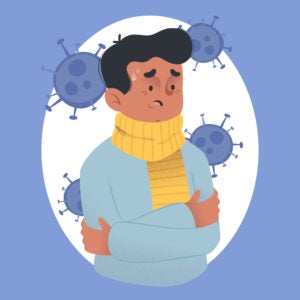 and develop a fever and symptoms, such as cough or difficulty breathing, call your healthcare provider for medical advice. If you are sick, you should stay home and stay away from others as much as possible. Many people will be able to recover at home; however, be sure to get care if you think it is an emergency. If you seek care, call ahead to make sure they know you may have COVID-19 so that healthcare workers can protect themselves.
and develop a fever and symptoms, such as cough or difficulty breathing, call your healthcare provider for medical advice. If you are sick, you should stay home and stay away from others as much as possible. Many people will be able to recover at home; however, be sure to get care if you think it is an emergency. If you seek care, call ahead to make sure they know you may have COVID-19 so that healthcare workers can protect themselves.
How to Protect Myself and My Family
Updated Should I use a facemask or face cover to prevent COVID-19?
You should cover your mouth and nose with a facemask when you are in public, for example at the grocery store. This is to protect others from the risk of getting COVID-19, since you could spread the virus to others even if you do not feel sick.
The facemask should cover the mouth and nose completely. Facemasks must not be shared, and each person should have their own facemasks.
Facemasks should not be used by people who have trouble breathing, or children under age 2 years, or people who are unable to remove the mask without help.
The facemask or face cover is not a substitute for distancing. You should continue to keep 6 feet between yourself and others. Hand washing is still very important, and hands should be washed before wearing the facemask.
Please see next FAQ for more information on different types of facemasks and face covers.
Adapted from- https://www.cdc.gov/coronavirus/2019-ncov/prevent-getting-sick/prevention.html
New What facemask or face cover should I wear?
Some masks offer higher levels of protection than others, and some may be harder to tolerate or wear consistently than others. It is most important to wear a well-fitting mask correctly that is comfortable for you and that provides good protection. If you constantly feel the need to touch and adjust your mask, then the mask is not well-fitting / comfortable and you may need to wear a different type of mask.
Loosely woven cloth face covers provide the least protection, tightly woven face covers with more than one layer offer more protection, well-fitting disposable surgical masks and KN95s offer even more protection, and well-fitting masks such as N95 respirators offer the highest level of protection.
N95s and KN95s can be expensive and there are many fake versions available that are not government-approved. The U.S. government has distributed N95 respirators to pharmacies that will be available for free. However, it might take some time before they are widely available. More information can be found at https://www.cdc.gov/coronavirus/2019-ncov/prevent-getting-sick/free-n95-manufacturers.html
In the meantime, if approved N95s and KN95s are not available to you, consider these ways to have a better fit and extra protection with cloth and disposable surgical masks:
- Wear two masks (disposable surgical mask underneath AND cloth face cover on top).
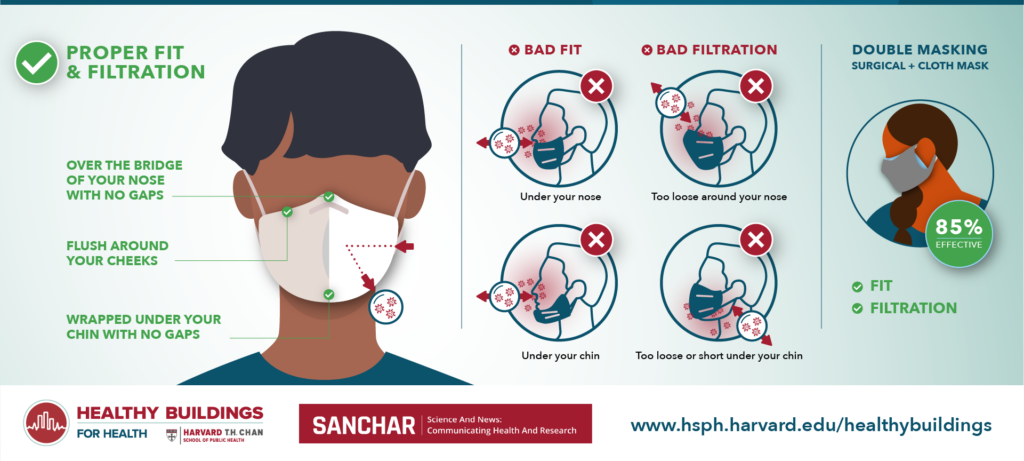
- Combine either a cloth mask or disposable surgical mask with a fitter or brace.
- Knot and tuck ear loops of a 3-layer mask where they join the edge of the mask.
- For disposable surgical masks, fold and tuck the extra material under the edges. For instructions, see the following video, available in English only: https://youtu.be/GzTAZDsNBe0
- Use masks that attach behind the neck and head with either elastic bands or ties (instead of ear loops).
REMEMBER: Any mask or face cover worn properly (fully covering both the nose and mouth) is better than none. All masks and face covers help slow the spread of the virus that causes COVID-19.
The CDC has a full guide on masking: https://www.cdc.gov/coronavirus/2019-ncov/prevent-getting-sick/types-of-masks.html
Updated What can I do to protect myself and my family from becoming infected with the Omicron variant?
Even as more information emerges on Omicron, preventive measures remain the same for it as for any other variant of COVID-19. As we have been doing throughout the pandemic, it is important to:
- Wear face coverings in public settings
- Maintain physical distance from those outside your household
- Regularly clean your hands for at least 20 seconds using soap and water, or if that is not available, an alcohol-based hand sanitizer
- If you feel sick – get tested and stay at home. You can get tested at home using the rapid antigen tests or at your nearest testing center using the PCR tests. These tests continue to detect infection, including infection with Omicron.
- Get vaccinated – the COVID-19 vaccine is approved for people ages 5 and over in the U.S., and people ages 12 and above are eligible for booster shots. Visit the CDC’s website for more information on eligibility and how to find a vaccine. While we are still waiting to find out how protective the vaccines are against Omicron, vaccines are the best public health tool to prevent against severe illness, hospitalization, and death from COVID-19.
Also, beware of misleading headlines and posts on social media. Wait to hear recommended actions from local, state, and federal government agencies. Until then, follow the recommendations here.
As schools re-open, what precautions are being taking to protect my child at school variant?
The CDC has a webpage dedicated to helping parents and caregivers understand what their local schools are doing to protect children from becoming infected with COVID-19. Sections include a list of questions parents and caregivers can ask the school and answers to some common questions CDC is hearing from parents and caregivers about masks, vaccines, ventilation/airflow in schools, testing, quarantining, school activities, and other topics.
Visit their page for more information: https://www.cdc.gov/coronavirus/2019-ncov/community/schools-childcare/parent-faqs.html
If I decide to go out, are outdoor activities safer than indoor activities?
The virus that causes COVID-19 is mostly spread through tiny droplets when people who are infected breathe, speak, cough, or sneeze. Some people who are infected do not feel sick, but they can still spread the virus. While there is always some amount of risk when meeting people you do not live with, indoor spaces are more risky than outdoor spaces. It is harder to stay apart indoors and there is less air flow. Remember to always wear a face covering to protect yourself and others, and maintain at least 6 feet or 2 meters of space between you and others. This is especially important when indoors.
Sources: https://www.cdc.gov/coronavirus/2019-ncov/daily-life-coping/deciding-to-go-out.html and https://www.regenhealthsolutions.info/wp-content/uploads/2020/05/Reducing-transmission-of-SARS-CoV-2.pdf
What steps can my family take to reduce our risk of getting COVID-19?
Practice everyday preventive actions to help reduce your risk of getting sick and remind everyone in your home to do the same. These actions are especially important for older adults and people who have chronic medical conditions:
- Avoid close contact with people who are sick.
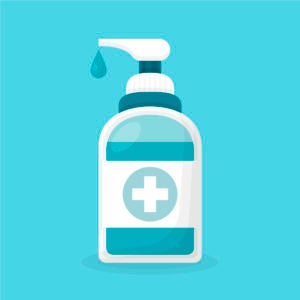
- Stay home when you are sick, except to get medical care.
- Cover your coughs and sneezes with the inside of your elbow or a tissue and throw the tissue in the trash. Then wash your hands.
- Wash your hands often with soap and water for at least 20 seconds, especially after blowing your nose, coughing, or sneezing; going to the bathroom; and before cooking or eating.
- If you do not have soap and water, use an alcohol-based hand sanitizer with at least 60% alcohol. Always wash hands with soap and water if hands are visibly dirty.
- Clean and disinfect surfaces and objects that people touch a lot (e.g. phones, other electronics, tables, countertops, light switches, doorknobs, and cabinet handles).
- Get vaccinated. For more details, click here.
How should I clean and disinfect my home in order to protect myself and my family from COVID-19?
If you think a surface may be infected, clean it with simple disinfectant to kill the virus and protect yourself and others. If surfaces are dirty, clean them using detergent or soap and water before you disinfect. After cleaning and disinfecting, clean your hands with an alcohol-based hand sanitizer or wash them with soap and water. Avoid touching your eyes, mouth, or nose.
On a regular basis, clean and disinfect frequently touched surfaces such as tables, doorknobs, light switches, countertops, handles, desks, phones, keyboards, toilets, faucets, and sinks.
The U.S. Centers for Disease Control and Prevention (CDC) has a full guide to cleaning and disinfecting here: https://www.cdc.gov/coronavirus/2019-ncov/prevent-getting-sick/disinfecting-your-home.html
Adapted from sources: https://www.cdc.gov/coronavirus/2019-ncov/faq.html
What does it mean to practice ‘social distancing’ or ‘physical distancing’?
- Keeping your distance from others (3-6 feet or 1-2 meters away).
- When taking public transportation, taxis, and ride-shares, always wear a mask and practice physical distancing whenever possible. If it is not possible to distance, try and sit or stand near other people who are masked.”
- Avoiding crowded places wherever possible.
What resources are available to me if I am struggling with issues related to sexual or domestic violence during this time?
Help and support are available to you. Many services for people struggling with issues related to sexual and domestic violence are available remotely during this COVID-19 public health emergency. Visit the Massachusetts Department of Public Health Domestic Violence Program and the Sexual Assault Prevention and Survivor Services pages for more information.
For information on services available in Lawrence, MA, please visit We Are Lawrence.
Please note that abusive people often misuse technology to track their partners’ activities. Clear your browser history after searching online for domestic violence services. Instructions on how to clear your browser history can be found here in English, Spanish, Portuguese, and other languages: https://www.mcedv.org/clear-history/.
Adapted from sources: https://www.mass.gov/info-details/frequently-asked-questions-about-covid-19 and https://www.wearelawrence.org/coronavirus-mentalhealth
Variants
What is a “variant” of the COVID-19 virus?
If you think about a virus like a tree growing and branching out, each branch on the tree is a little different than the others. By comparing the branches, scientists can label them according to the differences. These small differences, or variants, have been studied and identified since the beginning of the pandemic. New variants of the virus are expected to occur. Sometimes new variants emerge and disappear. Other times, new variants persist. Many variants of the virus that causes COVID-19 are being tracked in the United States and globally during this pandemic.
Some variants allow the virus to spread more easily or make it resistant to treatments or vaccines. Those variants must be monitored more carefully.
Most variants cause similar COVID-19 symptoms. All COVID-19 tests can detect all variants, but they will not tell you which variant you have. FDA approved or authorized COVID-19 vaccines protect against known variants. It is very important for every eligible person to get vaccinated as soon as possible to prevent getting infected and severely ill and strongly reduce the likelihood of hospitalization and death. Visit our vaccines page to learn more.
Here is a 90-second video from the CDC about variants: https://www.youtube.com/watch?v=p1BMvCBrYs8&t=88s
What is the Omicron variant?
It is a new variant of the virus that causes COVID-19 that was discovered in November 2021. Scientists are yet to determine how quickly Omicron spreads and the level of severity of disease it causes. While there are many claims from initial studies about the new variant’s ability to spread faster or evade immunity provided by vaccination, the studies are still ongoing. It will take time to understand the impact of the Omicron variant.
What can I do to protect myself and my family from becoming infected with the Omicron variant?
Even as more information emerges on Omicron, preventive measures remain the same for it as for any other variant of COVID-19. As we have been doing throughout the pandemic, it is important to:
- Wear face coverings in public settings
- Maintain physical distance from those outside your household
- Regularly clean your hands for at least 20 seconds using soap and water, or if that is not available, an alcohol-based hand sanitizer
- If you feel sick – get tested and stay at home. You can get tested at home using the rapid antigen tests or at your nearest testing center using the PCR tests. These tests continue to detect infection, including infection with Omicron.
- Get vaccinated and boosted – the COVID-19 vaccine is approved for people ages five and over in the U.S., and many adults are eligible for booster shots. Visit the CDC’s website for more information on eligibility and how to find a vaccine. While we are still waiting to find out how protective the vaccines are against Omicron, vaccines are the best public health tool to prevent against severe illness, hospitalization, and death from COVID-19.
Also, beware of misleading headlines and posts on social media. Wait to hear recommended actions from local, state, and federal government agencies. Until then, follow the recommendations here.
Higher Risk
Who is at risk for serious complications from COVID-19?
People of all ages can become infected with COVID-19, but some people are at higher risk of getting very sick from this illness. This includes:
- Older adults
- People who have underlying chronic medical conditions like heart disease, diabetes, lung disease
This does not, however, mean that other groups won’t fall sick or are immune from it. Everyone is at risk; some more than others.
Are people with disabilities at higher risk for COVID-19 infection or severe illness?
Most people with disabilities are not inherently at higher risk for becoming infected with or having severe illness from COVID-19. Some people with physical limitations or other disabilities might be at a higher risk of infection because of their underlying medical condition.
You should talk with your healthcare provider if you have a question about your health or how your health condition is being managed.
Adapted from source: https://www.cdc.gov/coronavirus/2019-ncov/faq.html#Higher-Risk
Please follow the links below for more information:
Boston Public Health Commission
CDC Pregnancy and Breastfeeding
Massachusetts Department of Public Health
Ministry of Health and Family Welfare, Government of India
World Health Organization (WHO) FAQs
CDC Symptom Description and Symptom Checker
This material was curated by Viswanath Lab of Harvard Chan School of Public Health and the Dana-Farber Cancer Institute (DFCI) with the help of the Health Communication Core of Dana-Farber/Harvard Cancer Center (DF/HCC). These are not the official views of Harvard Chan or DFCI. For any questions, comments or suggestions reach out to rpinnamaneni@hsph.harvard.edu.

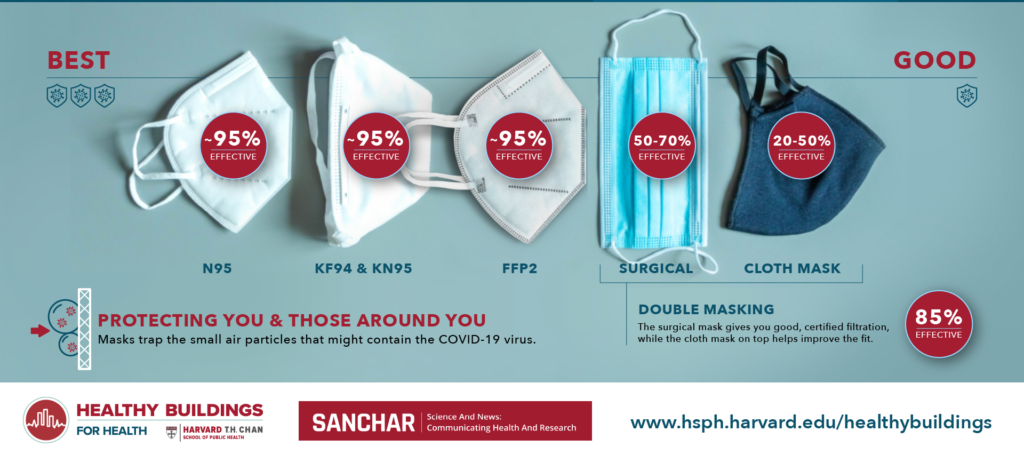
You must be logged in to post a comment.